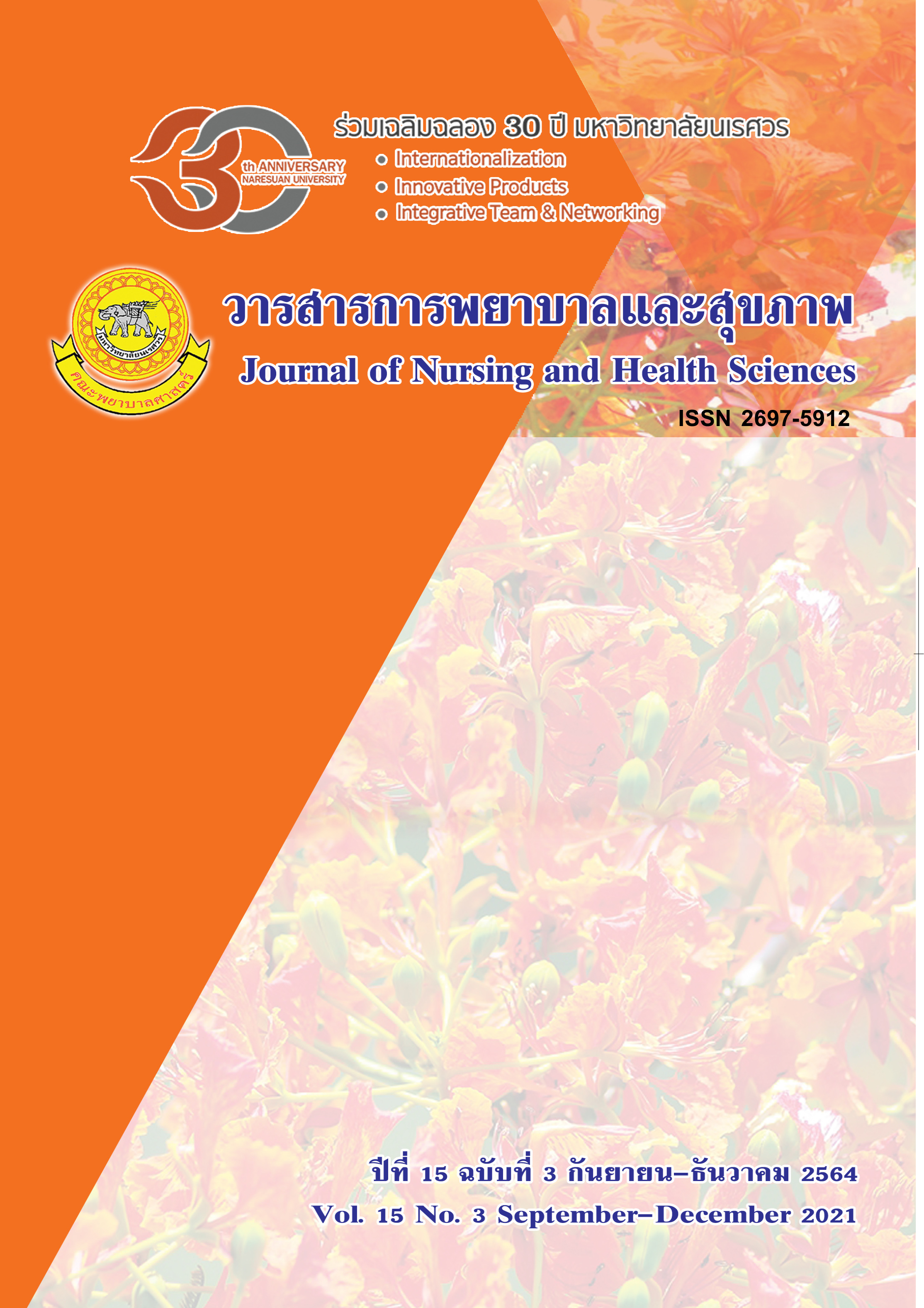ปัจจัยทำนายความเสี่ยงโรคสมาธิสั้นของนักเรียนชั้นประถมศึกษาตอนต้นตามการรับรู้ของผู้ปกครอง
Main Article Content
บทคัดย่อ
การวิจัยนี้เป็นการวิจัยเชิงพรรณนา มีวัตถุประสงค์เพื่อศึกษาความสามารถร่วมกันทำนายของปัจจัยด้านตัวเด็ก ประกอบด้วย เพศ ถูกครูทำโทษ ครูเรียกพบผู้ปกครอง เรียนซ้ำชั้น หยุดพักการเรียน เปลี่ยนโรงเรียน และการอยู่อาศัย ปัจจัยด้านครอบครัว ประกอบด้วย ความรักความเอาใจใส่ การอบรมเลี้ยงดู การดูแลสุขภาพ และการจัดสรรรายได้ของครอบครัว ปัจจัยด้านสิ่งแวดล้อม ประกอบด้วย ระยะเวลาในการใช้สื่อเทคโนโลยี และพฤติกรรมการติดสื่อเทคโนโลยี กับความเสี่ยงโรคสมาธิสั้นของนักเรียนชั้นประถมศึกษาตอนต้นตามการรับรู้ของผู้ปกครอง กลุ่มตัวอย่าง คือ ผู้ปกครองของเด็กที่กำลังศึกษาในระดับชั้นประถมศึกษาตอนต้น โรงเรียนสังกัดสำนักงานเขตพื้นที่การศึกษาประถมศึกษาพิษณุโลกเขต 1 อ.เมือง จ.พิษณุโลก จำนวน 358 รายโดยวิธีการสุ่มแบบหลายขั้นตอน เก็บข้อมูลโดยใช้แบบสอบถามประกอบด้วย 6 ส่วน คือ 1) ข้อมูลทั่วไปของผู้ปกครอง 2) ข้อมูลทั่วไปของเด็ก 3) แบบสอบถามปัจจัยด้านตัวเด็ก 4) แบบสอบถามปัจจัยด้านครอบครัว 5) แบบสอบถามปัจจัยด้านสิ่งแวดล้อม และ 6) แบบประเมินพฤติกรรม SNAP IV ฉบับภาษาไทย ซึ่งผ่านการตรวจสอบคุณภาพด้านความตรงเชิงเนื้อหาและความเที่ยงตามเกณฑ์มาตรฐาน วิเคราะห์ข้อมูลโดยใช้สถิติความถี่ ร้อยละ ค่าเฉลี่ย ส่วนเบี่ยงเบนมาตรฐาน สัมประสิทธิ์สหสัมพันธ์แบบเพียร์สัน ทดสอบไคสแควร์ และการวิเคราะห์ถดถอยโลจิสติกทวิผลการวิจัยพบความเสี่ยงโรคสมาธิสั้นของนักเรียนชั้นประถมศึกษาตอนต้นร้อยละ 39.4 โดยพบกลุ่มอาการซนอยู่ไม่นิ่งมากที่สุดร้อยละ 34.7 และปัจจัยที่มีความสัมพันธ์กับความเสี่ยงโรคสมาธิสั้นของนักเรียนชั้นประถมศึกษาตอนต้น ได้แก่ ครูเรียกพบผู้ปกครอง, การเรียนซ้ำชั้น พฤติกรรมการติดสื่อเทคโนโลยี (r =.361) และการจัดสรรรายได้ของครอบครัว (r = -.189) ซึ่งสามารถทำนายความเสี่ยงโรคสมาธิสั้นได้ร้อยละ 35.1 และมีประสิทธิภาพการทำนายถูกต้องร้อยละ 72.1 อย่างมีนัยสำคัญทางสถิติที่ระดับ .05 เขียนสมการถดถอยโลจิสติก (y) = -.899 +4.052 (ครูเรียกพบผู้ปกครอง) +3.436 (เรียนซ้ำชั้น) -.072 (การจัดสรรรายได้ครอบครัว) +.113 (พฤติกรรมการติดสื่อเทคโนโลยี) ผลการศึกษานี้สามารถนำไปพัฒนาเป็นแนวทางการป้องกันการเกิดโรคสมาธิในนักเรียนชั้นประถมศึกษาตอนต้นได้
Article Details

อนุญาตภายใต้เงื่อนไข Creative Commons Attribution-NonCommercial-NoDerivatives 4.0 International License.
เอกสารอ้างอิง
American Academy Pediatric. (2019). Clinical practice
guideline for the diagnosis, evaluation, and treatment
of attention-deficit/hyperactivity disorder in
children and adolescents. Retrieved 28 June 2020
from https://pediatrics.aappublications.org/content/
/4/e20192528.
Augsornrat, S. (2006). Family structure, family functions
and sexual risk behaviors among female
junior high-school students, muang district,
Nakhon Si Thammarat Province. Master Thesis
(Nursing Science), Prince of Songkhla University,
Songkhla. [In Thai].
Beyens, I., Valkenburg, P. M. &Piotrowski, J. T. (2018).
Screen media use and ADHD-related behaviors:
Four decades of research. Proceedings of the
National Academy of Sciences of the United States
of America, 115(40), 9875-9881. doi:10.1073/
pnas.1611611114.
Boonyasidhi, V. (2012). Attention deficit hyperactivity
disorder: Diagnosis and management. Journal
of Psychiatric Association of Thailand, 57(4),
-386. [In Thai].
Chan-em, S. (1999). Developmental psychology (5th ed).
Bangkok: Thai Wattana Panich. [In Thai].
Cochran, W. G. (1977). Sampling techniques (3rd ed.).
New York: John Wiley & Sons.
Gaub, M. and Carlson, C. L. (1997). Gender differences
in ADHD: A meta-analysis and critical review.
Journal of the American Academy of Child &
Adolescent Psychiatry, 36(8), 1036-1045. doi: https://
doi.org/10.1097/00004583-199708000-00011.
Health Data Center. (2014). Patients with ADHD have
access to services (workload). Retrieved 4 July
from https://hdcservice.moph.go.th/hdc/
reports/report.php?source=pformated/format1.
php&cat_id=22710ed5db1ed6b12aab540a7b0
b3&id=90ccfbfd92f7d1bdd89d0cfd 8b4e46ec.
Hurtig, T., Ebeling, H., Taanila, A., Miettunen, J., Smalley,
S., McGough, J. etal. (2007). ADHD and comorbid
disorders in relation to family environment
and symptom severity. Eur Child Adolesc
Psychiatry, 16(6), 362-369. doi:10.1007/s00787-
-0607-2.
Ketumarn, P., Hataiyusuk, S. , Pornnoppadol, C., &
Apinuntavech, S. (2016). Prevalence and factors
associated with attention-deficit hyperactivity
disorder in male juvenile delinquent of Metta
remand home. Journal of Psychiatric Association of Thailand, 61(1), 27-39. [In Thai].
Kid Zone of Teen. (2018, 11 March). Department of
Mental Health revealed Thai children are
resistant to disease. Ignore the rules, Komchadluek.
Retrieved 11 November 2020 from https://www.
komchadluek.net/news/edu-health/316105.
Mahone, E. M., Crocetti, D., Ranta, M. E., Gaddis, A.,
Cataldo, M., Slifer, K. J., . . . Mostofsky, S. H.
(2011). A preliminary neuroimaging study of
preschool children with ADHD. The Clinical
Neuropsychologist, 25(6), 1009-1028. doi:10.
/13854046.2011.580784
Ngamkum, D., & Yunibhan, J. (2013). Relationships
between family factors and behavioral problems
in children with attention-deficit hyperactivity
disorder, Eastern Region. The Journal of
Psychiatric Nursing and Mental Health, 27(1),
-28. [In Thai].
Nikkelen, S. W., Valkenburg, P. M., Huizinga, M. and
Bushman, B. J. (2014). Media use and ADHDrelated behaviors in children and adolescents:
A meta-analysis. Dev Psychol, 50(9), 2228-2241.
doi: 10.1037/a0037318.
Phanichsiri, K., & Tuntasood, B. (2016). Social media
addiction and attention deficit and hyperactivity
symptoms in high school students in Bangkok.
Journal of Psychiatric Association of Thailand,
(3), 191-204. [In Thai].
Phongsathirat, P., & Wachiradilok, P. (2013). Factors
associated with attention deficit hyperactivity
disorders in school-age children. The Journal of
Psychiatric Nursing and Mental Health, 27(1),
-120. [In Thai].
Pityaratstian, N., Booranasuksakul, T., Juengsiragulwit,
D., & Benyakorn, S. (2014). ADHD screening
properties of the Thai version of Swanson, Nolan,
and Pelham IV scale (SNAP-IV) and strengths
and difficulties questionnaire (SDQ). Journal of
Psychiatric Association of Thailand, 59(2), 97-110.
[In Thai].
Pornnoppadol, C., Piyasilp, V., Jittorn, J., & Chanpen, S.
(2014). The development of screening scales
forattention deficit hyperactivity disorder
(ADHD) in Thai children and adolescents age
of 3-18 years. Journal of Psychiatric Association
of Thailand, 59(4), 335-354. [In Thai].
Sakboonyarat, B., Chokcharoensap, K., Sathuthum, N.,
Chutchawalanon, S., Khamkaen, C., Sookkaew,
W., . . . Rangsin, R. (2018). Prevalence and
associated factors of attention deficit hyperactivity
disorder (ADHD) in a rural community, central
Thailand: A mixed methods study. Global Journal
of Health Science, 10, 60. doi:10.5539/gjhs.v10n3
p60.
Saksritavee, B., Chanwanpen, E., & Phenwan, T.
(2019). Factors associated with attention deficit/
hyperactivity disorders in school aged children of
Sichon hospital in crossectional study. Region 11
Medical Journal, 33(2), 327-338. [In Thai].
Schonwald, A. (2005). Update: Attention deficit/hyperactivity disorder in the primary care office.
Curr Opin Pediatr, 17(2), 265-274. doi:10.1097/
mop.0000156983.71532.eb.
Siribunphiphatana, P. (2001). Pediatric nursing, volume 1.
Nonthaburi: Yuttarin printing. [In Thai].
Sirithongthaworn, S., Kanjanarat, P., Itsarapong, P.,
Pila, S., Pattanakitkosol, P., Sonsingh, W.,…
Kamduang, N. (2017). Development of integrated
care model for children with attention deficit
hyperactivity disorder among health care
professionals, parents, and teachers in in
Northern Thailand (Research report). Bangkok:
Health systems research institute. [In Thai].
Suripon, P., Siri, S., Sujirarat, D., & Pitikultang, S.
(2019). Screen-based media use and attention
deficit hyperactivity disorder among male
students, elementary school, Proceeding of
Rangsit university national research conference
[In Thai].
Visanuyothin, T., Pavasuthipaisit, C., Wachiradilok, P.,
Arunruang, P., & Buranasuksakul, T. (2013).
The prevalence of attention deficit/hyperactivity
disorder in Thailand. Journal of Mental Health
of Thailand, 21(2), 66-75. [In Thai].
Wamulugwa, J., Kakooza, A., Kitaka, S. B., Nalugya,
J., Kaddumukasa, M., Moore, S., . . . Katabira, E.
(2017). Prevalence and associated factors of
attention deficit hyperactivity disorder (ADHD)
among Ugandan children; a cross-sectional study.
Child Adolesc Psychiatry Ment Health, 11, 18. doi:
1186/s13034-017-0155-6
Weerakul, J. (2014). Attention deficit hyperactivity
disorder in children. Buddhachinaraj Medical
Journal, 31(1), 65-75. [In Thai].


